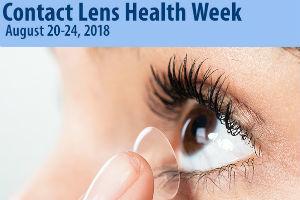August 19th – 23rd is the sixth annual Contact Lens Health Week, sponsored by the CDC.[1] CooperVision® is proud to be a Contact Lens Health Week partner and to bring to you resources available from the CDC and others to communicate key messages about contact lens health to your patients. We’ve also summarized relevant literature content to help you stay up-to-date with the latest findings on contact lens health.
The theme of this year’s contact lens health week is “contact lens health starts with you” and the messages focus on 3 key areas:
- Improving communication about healthy contact lens hygiene habits between eye care providers and patients
- Risks associated with improper contact lens use
- The importance of regular visits to an eye care provider
Focus Area 1 - Improving Communication with Patients about Healthy Contact Lens Hygiene Habits
A 2015 survey of US contact lens wearers by the CDC revealed that 99% of survey respondents engaged in at least one risky behavior with their contact lenses.[2] The top risky behaviors found were found to be:
- -Keeping their contact lens cases for longer than recommended (82.3 percent);
- -“Topping off” solution in the case—adding new solution to the existing solution instead of emptying the case out fully before adding new solution (55.1 percent); or
- -Wearing their lenses while sleeping (50.2 percent).
According to the CDC - each of these behaviors has been reported in previous studies to raise the risk of eye infections by five times or more. As part of contact lens health week, the CDC has provided patient communication tools including in-office posters, videos, and social media posts to communicate that these behaviors are risky.
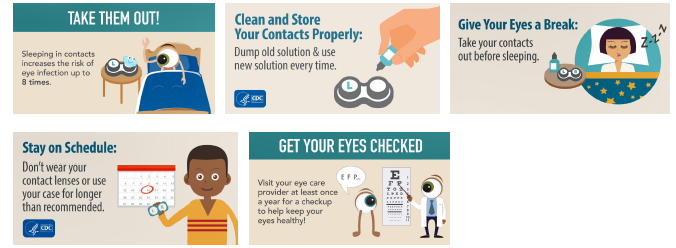
Communication with patients is key as several patient surveys have shown that patients may be unaware of proper lens case replacement schedules[3] or even proper handwashing protocols for healthy contact lens wear. In addition, to the communication tools that are available from the CDC and AOA, Dr. Robertson has shared some “real world strategies” for improving patient compliance in this recent article in review of cornea and contact lens.[4]
In addition to communicating the risks of these non-compliant behaviors to your patients and encouraging proper hygiene practices, you can also make it easier for them to be compliant by recommending 1 day contact lenses. Several wearer surveys have shown that 1 day contact lens wearers tend to be more compliant with replacements schedules than 2 weekly or monthly wearers. 3,[5] Furthermore, 1 day contact lenses take contact lens solutions and contact lens cases out of the equation for wearers, further reducing common areas of non-compliance that can lead to risks for healthy wear of contact lenses.2, [6]
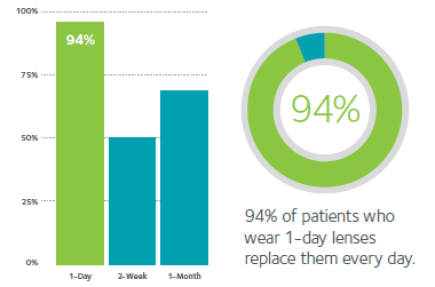
Compliance with Manufacturer’s Suggested Replacement of Various Lens Modalities. (Adapted from Reference 5B)
In order to shed more light on ECP and wearer attitudes around contact lens wear and health, CooperVision recently conducted a survey of both contact lens wearers[7] and ECPs[8] to understand their attitudes toward silicone hydrogel 1 day lenses. The ECP survey revealed that ECPs recognized the ocular health benefits of silicone hydrogels[9], and when questioned, nine out of ten eye care professionals (ECPs) agreed that they are the healthiest option for their daily disposable patients.[10] In fact, health was ranked as the most important category for ECPs who fit 1 day SiHy lenses. Nonetheless, a concern about cost to the patient was cited as the #1 reason why ECPs didn’t prescribe what they believed to the healthiest option to their patients.10 Conversely, patients expressed an interest in health and a willingness to follow the advice of their ECP regardless of cost.[11] This suggests that communication by the ECP about options for healthy contact lens wear will be of keen interest to the contact lens wearer.
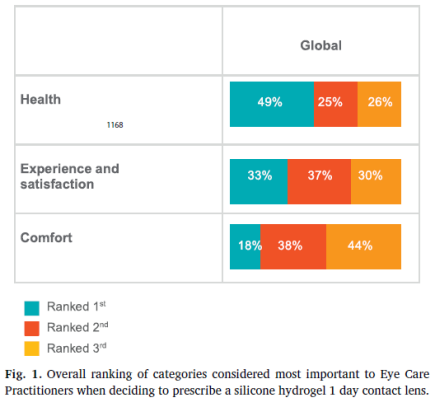
Overall Ranking of Categories Considered Most Important to Eye Care Practitioners when Deciding to Prescribe a SiHy 1 Day CL.8
Focus Area 2 – Risks Associated with Improper Contact Lens Use
The risks associated with improper contact lens use have been thoroughly documented in the scientific literature and an extensive library of these articles can be found at the CDC website.[12] However, most of the contact lens wear population does not read the scientific literature. Education about risks associated with improper contact lens use needs to be communicated not just to new wearers but longer-term wearers also need to be reminded of the importance of following proper cleaning, disposal, and usage guidelines as new information on risks is always being discovered.
An increase of Acanthamoeba keratitis cases in some parts of the world, particularly the UK, has highlighted the risks of water and contact lenses.[13] While this risk has been known for some time a recent review article found that, despite the documented risks due to water exposure, water-related habits are common among CL wearers.14 The article found that discrepancies exist in guidelines for CL hygiene and compliance globally.14 The article concludes that guidelines should unequivocally advocate for the avoidance of any water exposure including handling CLs with wet hands, rinsing CLs or storage cases in tap water, showering while wearing CLs and swimming with CLs without wearing goggles.[14] This echoes the recommendations made by the CDC13, FDA[15], AAO[16] and AOA[17], respectively. Contact lens manufacturers, like CooperVision, have also been proactive in sharing the risks of water exposure and contact lenses.[18] The CDC's resources can be useful tools to communicate the risk of water exposure and contact lenses, and other risky behaviors, in a variety of media including posters for your practice and social media campaigns.
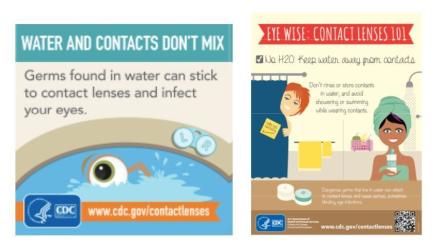
Focus Area 3 - The importance of regular visits to an eye care provider
Patient ocular health is best served when the ECP is at the center of the patient/contact lens experience. Data has shown that contact lens patients are actually more compliant with annual exams than spectacles-only patients.[19] This is encouraging, but what else can be done to maximize the chances that contact lens patients are compliant with annual exams? The first step is communication. While the difference between a comprehensive eye exam and simple vision screening is obvious to ECPs, many patients may not know the difference. Together we can educate patients that a simple refraction test is no substitute for a comprehensive eye exam.
The CDC and AOA have provided patient education web pages that articulate the value of a comprehensive eye exam in early detection of diseases that can impact vision and also early detection of other important health issues, such as diabetes and high blood pressure.[20] AllAboutVision.com also has a more comprehensive, patient-facing guide to what constitutes a medical eye exam.[21] By ensuring that patients understand that the benefits and importance of a comprehensive eye exam go beyond refraction, you can influence your patients to be more compliant with the annual eye care exam schedule. Research has also shown that 1 day contact lens wearers return to their ECP more regularly than biweekly or monthly contact lens wearers.[22]
CooperVision is proud to partner with the CDC for Contact Lens Health Week and is excited to bring you a comprehensive guide to information and resources to support your patient education efforts during contact lens week and all year long. The CDC has put together the following list of additional resources specifically for ECPs to support patient communication about contact lens Health:
- -Order FREE POSTERS to display in your office or clinic
- -Order FREE TEAR OFF PADS that include healthy contact lens habits to share with your patients during their routine eye appointment
- -Tune in to the Facebook Live chat at 2:00pm EDT on August 19, 2019 and promote it to your state/local association
- -Follow the CDC on social media and share contact lens health tips with the hashtag #OnePairTakeCare.
For more information on CooperVision’s 1 day contact lens portfolio talk to your CooperVision sales representative or research our 1 day lenses at https://coopervision.com/practitioner/our-products.
For more tips on how to start the 1 day conversation with patients, go to https://coopervision.com/practitioner/clinical-resources/moving-frequent-replacement-contact-lens-wearers-1-day-lenses.
[1] https://www.cdc.gov/contactlenses/contact-lens-health-week.html
[2] https://archive.cdc.gov/#/details?url=https://www.cdc.gov/media/releases/2015/p0820-contact-lens.html
[4] https://www.reviewofcontactlenses.com/article/real-world-strategies-for-improving-contact-lens-compliance
[5] A) Jones L, Jones D and Simpson T. The impact of replacement frequency and care regimen on subjective satisfaction with disposable and frequent replacement lenses. Optom Vis Sci 1999; 76(12s);172. B) Compliance and Contact lenses. Review of Cornea and Contact Lens. March 2006.
[6] Versus reusable soft CLs (2-week or monthly replacement). REF: Chalmers RL, Hickson-Curran SB, et all. Rates of adverse events with hydrogel and silicone hydrogel daily disposable lenses in a large postmarket surveillance registry: the TEMPO registry. Invest Ophthalmol Vis Sci 2015; 56: 654-663
[7] https://coopervision.com/practitioner/clinical-resources/one-day-silicone-hydrogel YouGov America Inc. Total sample size was 1520 adults in U.S. and Germany who wear contact lenses. Fieldwork was undertaken between 3/26/2018 – 4/3/2018. The survey was carried out online. Data on file.
[9] Note: Survey results of n=300 ECPs in US, UK and Japan - Feb 2018.
[10] ECP Perceptions of the Benefits of 1-Day Silicone Hydrogels. Survey results of n=100 ECPs in US. February 2018. Cello Health Insight. Data on file.
11 n=1193; December 2015 contact lens wearer survey. Data on file.
[12] A) https://www.cdc.gov/contact-lenses/about/index.html B) https://www.cdc.gov/contact-lenses/about/index.html
[13] https://www.cdc.gov/contact-lenses/about/healthy-habits-keeping-water-away-from-contact-lenses.html
[14] https://journals.lww.com/corneajrnl/Abstract/2019/06000/Water_Exposure_and_the_Risk_of_Contact.23.aspx
[16] https://www.aao.org/eye-health/glasses-contacts/video-protect-sight-from-contact-lens-infections
[19] CL Spectrum. 2006 March
[20] A) https://www.cdc.gov/vision-health/ B) https://www.aoa.org/patients-and-public/caring-for-your-vision/comprehensive-eye-and-vision-examination/limitations-of-vision-screening-programs
[22] Optom Vis Sci. 2013 Apr;90(4):351-8. doi: 10.1097/OPX.0b013e318288afcb.






